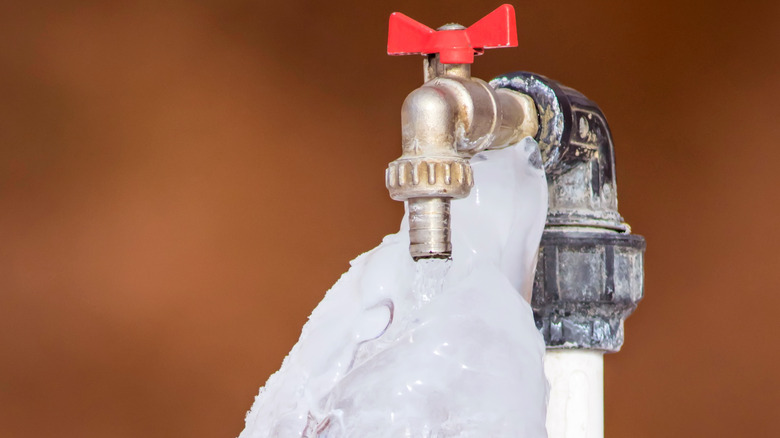This article directly below about Helpful Tips to Prevent Frozen Pipes this Winter is seriously captivating. Check it out for your own benefit and decide what you think about it.

Cold weather can wreak havoc on your plumbing, particularly by freezing pipes. Below's just how to stop it from occurring and what to do if it does.
Introduction
As temperatures decrease, the threat of icy pipelines rises, possibly leading to expensive repair work and water damages. Recognizing exactly how to stop icy pipelines is important for house owners in cold environments.
Prevention Tips
Protecting vulnerable pipes
Wrap pipelines in insulation sleeves or use warmth tape to secure them from freezing temperature levels. Focus on pipelines in unheated or exterior areas of the home.
Heating strategies
Keep indoor areas properly heated up, particularly areas with pipes. Open up cabinet doors to enable warm air to flow around pipelines under sinks.
Just how to recognize frozen pipelines
Seek lowered water circulation from taps, unusual smells or sounds from pipes, and visible frost on exposed pipes.
Long-Term Solutions
Structural adjustments
Consider rerouting pipelines away from outside wall surfaces or unheated areas. Include added insulation to attics, cellars, and crawl spaces.
Updating insulation
Purchase premium insulation for pipes, attics, and walls. Proper insulation helps maintain regular temperature levels and lowers the risk of icy pipes.
Securing Outdoor Plumbing
Yard tubes and outdoor faucets
Detach and drain pipes yard tubes before wintertime. Mount frost-proof spigots or cover outside taps with protected caps.
Comprehending Icy Pipelines
What triggers pipelines to ice up?
Pipes freeze when subjected to temperature levels listed below 32 ° F (0 ° C) for extended periods. As water inside the pipes ices up, it broadens, taxing the pipeline walls and potentially causing them to break.
Threats and problems
Frozen pipelines can cause water system disruptions, home damage, and costly repair services. Ruptured pipes can flooding homes and cause considerable structural damages.
Signs of Frozen Piping
Identifying frozen pipelines early can stop them from breaking.
What to Do If Your Pipelines Freeze
Immediate activities to take
If you presume icy pipelines, maintain taps open to eliminate stress as the ice melts. Make use of a hairdryer or towels taken in warm water to thaw pipes gradually.
Verdict
Protecting against frozen pipes requires proactive procedures and fast responses. By understanding the causes, signs, and preventive measures, homeowners can safeguard their plumbing during cold weather.
6 Proven Ways to Prevent Frozen Pipes and Protect Your Home
Disconnect and Drain Garden Hoses
Before winter arrives, start by disconnecting your garden hoses and draining any remaining water. Close the shut-off valves that supply outdoor hose bibs and leave the outdoor faucet open to allow any residual water to drain. For extra protection, consider using faucet covers throughout the colder months. It’s also important to drain water from any sprinkler supply lines following the manufacturer’s directions.
Insulate Exposed Pipes
Insulating your pipes is an effective way to prevent freezing. Pipe insulation is readily available at home improvement stores and is relatively inexpensive. Pay close attention to pipes in unheated areas such as the attic, basement, crawl spaces, or garage. Apply foam insulation generously to create a buffer against the cold. You can also wrap your pipes in heat tape or thermostat-controlled heat cables for added warmth.
Seal Air Leaks
Inspect your home for any cracks or openings that could let in cold air. Seal any holes around the piping in interior or exterior walls, as well as the sill plates where your home rests on its foundation. Additionally, make sure to keep your garage door closed unless you’re entering or exiting. Leaving it open creates a significant air leak that can lead to frozen pipes.
Allow Warm Air Circulation
During cold snaps, it’s essential to allow warm air to circulate evenly throughout your home. Leave interior doors ajar to promote better airflow. Open kitchen and bathroom cabinets to help distribute heat consistently around the rooms. If you have small children or pets, be sure to remove any household chemicals or potentially harmful cleaners from open cabinets for safety.
Let Faucets Drip
A small trickle of water can make a big difference in preventing ice formation inside your pipes. When temperatures drop significantly, start a drip of water from all faucets served by exposed pipes. This continuous flow helps prevent the water from freezing. Additionally, running a few faucets slightly can relieve pressure inside the pipes, reducing the chances of a rupture if the water inside does freeze.
https://choateshvac.com/6-proven-ways-to-prevent-frozen-pipes-and-protect-your-home/

I was shown that editorial about Preventing and dealing with frozen pipes through someone on our other web property. Are you aware of somebody who is excited about the topic? Feel free to share it. Thank-you for your time spent reading it.
Get Started